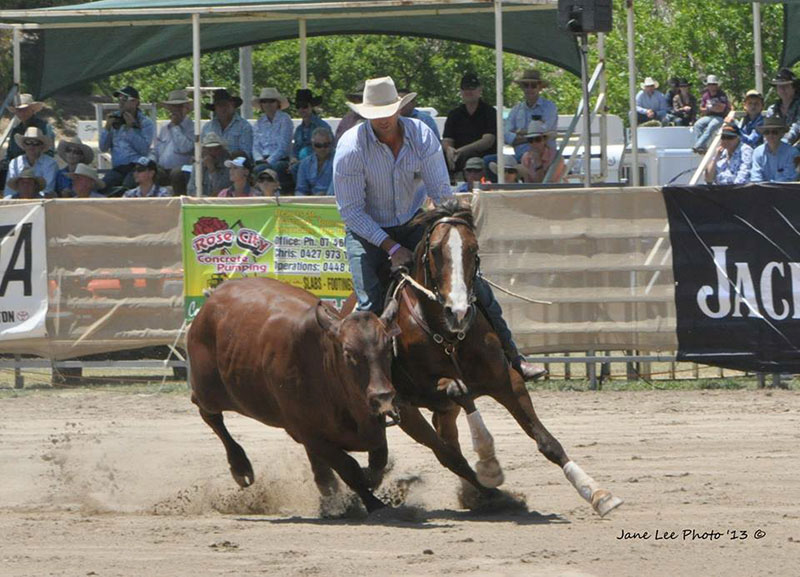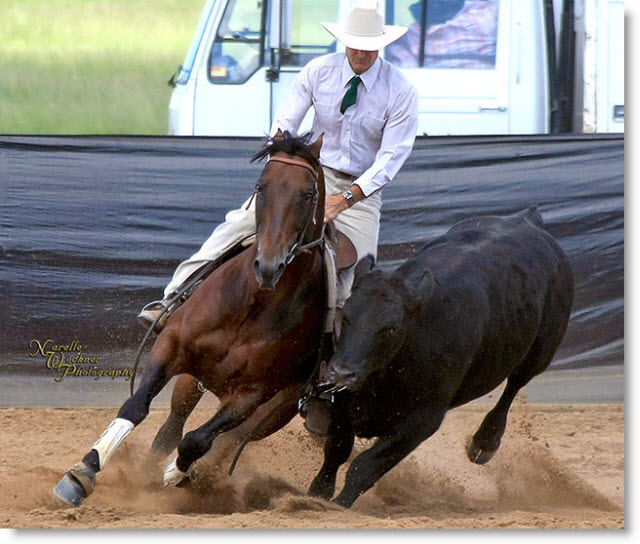
Campdrafting has its origins with the pioneering stockmen of the Australian bush. It is believed to have begun in outback Queensland, with stockmen having informal competitions for entertainment.
As with American rodeo events, such as cutting, working cow horse and team penning it is obvious that all these events, including Campdrafting, are based on the skills required to work with cattle.
When droving or mustering thousands of head of cattle on the open plains of the Australian outback, the stockmen would need to ‘cut out’ a beast from the mob (herd). The beast may need to be castrated or branded, so to remove it the stockman had to block it from returning to the herd. The beast could then be moved to a holding yard or thrown to the ground where the procedure was performed.
The sport of Campdrafting was eventually developed as a way of proving the skills of the horse and rider. This earned them respect amongst their peers, as well as increasing the value of their horse.

The first formal Campdrafting competition was held at the Tenterfield Show in 1885. Competing at this event was Clarence Smith, a cattleman and horse breeder. Clarence Smith went on to create the rules and judging procedures for the sport, which haven’t changed much since.
In a Campdrafting competition, a mounted rider moves into a small yard and selects one beast from a small mob of cattle. He or she then proceeds to move the beast towards the camp opening, which is blocked by two gates with men holding them shut. The mounted rider blocks and turns the beast several times across the face of the camp to demonstrate the horse’s ability to hold the beast away from the mob. When the rider feels that they have shown the judge enough he or she calls for the gates to be opened and they move out into a larger arena to complete the course (the run).
The course consists of two pegs set apart, one on the left and one on the right directly out from the camp gate. Some distance from these pegs are another two pegs that are set close together and represent the gate. The judge declares at the beginning of competition whether the course is left hand or right hand. If the course is right hand the rider must complete a circle around the right hand peg first, then changeover in the middle and complete a circle around the left hand peg. The rider then drives the beast out behind the gate and pushes it through the gate. At this point, the rider has finished the ‘run’, which must be completed in less than 40 seconds.
The score is out of 100 points. This cut out is worth a maximum of 26 points, the ‘run’ a maximum of four points and a further possible 70 points for ‘horsework’. A good Campdrafter is not just a fine horseman, but also needs cattle skills to select a beast that will run well.

All competitors in Australia ride under the National Campdrafting Council of Australia (NCCA) rules.
The prestige associated with a win in a large Campdrafting competition is invaluable to the owner of the horse. Not only do some of the richest drafts carry substantial prize money, the winning horse is ranked amongst the finest stock horses in the country. The owners of the top horses are able to charge large service fees in the following stud seasons. An important win can increase the bloodline’s worth by tens of thousands of dollars.
One famous horse in Campdraft history was Radium, an outstanding Australian-bred stock horse and a very influential ancestor of Australian Stock Horse Society breed registry. Radium’s owner, Donald Beaton often drove long distances to compete at bushman’s carnivals with Radium tied behind the buggy. Radium would then compete in the Campdraft, often winning, and if he was going well he would round off his success with an exhibition of Campdrafting without a bridle.
In 1928, Radium was sold to Herb O’Neil, who had ridden the horse in competitions for Beaton, when he had been unable to get away from his property. Herb O’Neil competed extensively with Radium, winning over a large area of the New South Wales. Just prior to the Second World War (WWII), Radium won a Championship Campdraft at Kempsey, New South Wales with the next ten placings going to Radium’s sons and daughters. During WWII, at a Dungog Bushman’s Carnival over 20 horses were competing in the led stock horse class. In this event Radium received the first placing with the remaining four places going to his sons.

Radium stood at stud on ‘Kunderang Station’ (now part of Oxley Wild Rivers National Park) for much of his life and had at least thirteen of his sons appear in Australian Stock Horse pedigrees. Quite a few horses had a double cross or were line-bred to this great foundation sire.
His son, Chan was one of the smartest horses seen in a cattle ‘camp’ and was a good sire. Another son, Dimray foaled in 1938 was a brilliant Campdrafter and when he retired to stud, he carried on the Radium tradition of producing top stock horses and Campdrafters. It was as a sire that Dimray had a tremendous influence with his son Reality, his grandson Rivoli Ray and his great grandson, Cecil Bruce all being included in the Australian Stock Horse Hall of Fame.
Of course, the sport of Campdrafting is open to all horse breeds. However, the Australian Stock Horse dominates the sport just as the Quarter Horse dominates the sports of Cutting and Reining.
Information courtesy of www.itsmypony.com
Campdrafting was originally the competition sport of the Australian Stock Horse. This breed of horse traditionally worked the cattle in the outback stock camps of Australia and the breed was developed primarily for their strength, their soundness, their type and their ability to work cattle. As the sport developed, so did the breed and it remains the true base of the Campdraft horse in Australia today.